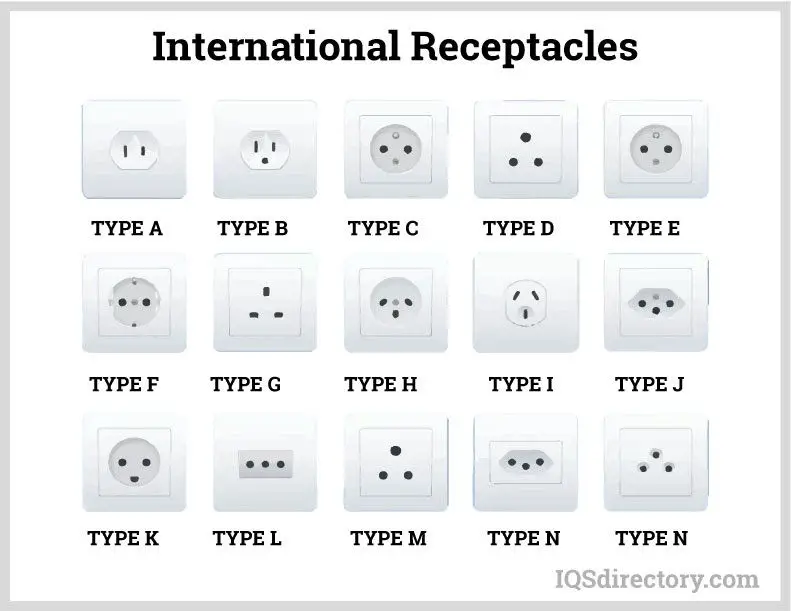What Is A Nema Standard Plug?
NEMA plugs and receptacles are standard connector types used for AC mains electricity in the United States, Canada, Mexico, and other countries that adhere to standards published by the National Electrical Manufacturers Association (NEMA). NEMA is an organization that develops standards for electrical products to promote safety and interchangeability.
NEMA connector standards ensure that plugs and outlets from different manufacturers are compatible with each other. They establish specifications for the dimensions, configuration, and ratings of plugs and receptacles. Having a standardized system prevents issues with mismatching connectors and improves safety.
The main purpose of NEMA standards is to provide safe and reliable power interconnections. Standardized connectors allow devices to be used across different brands and enable the electrical grid infrastructure to work seamlessly.
History
The National Electrical Manufacturers Association (NEMA) was formed in 1926 to standardize the electrical products being produced by various companies in the United States. Early NEMA plug and receptacle designs were based on Harvey Hubbell’s 1904 patent for a twist-lock plug and receptacle.
The NEMA 1-15 plug was one of the earliest NEMA standards approved in the 1930s. It had two flat parallel prongs and was intended for 15 amp 125 volt circuits. Over the years, NEMA has approved additional plug standards for different amperages, voltages, and configurations, like the NEMA 5-15 and NEMA 14-50.
Some key changes and developments for NEMA plugs and receptacles over the years include:
- Introducing grounding pins for safety
- Redesigning the neutral slot for polarization
- Adding tamper-resistant shutter mechanisms
- Updating rating requirements and dimensions
Today there are over 20 types of NEMA standard plugs and receptacles in use. NEMA connectors continue to evolve and new designs are introduced as electrical demands change.
NEMA Plug Types
There are several common types of NEMA plugs used in North America for residential and commercial electrical wiring:
-
NEMA 5-15 – This is the standard plug type used for 15 amp, 120 volt circuits in North America. It has two flat parallel blades and one round grounding pin. It’s commonly used for lighting, outlets, and small appliances.
-
NEMA 5-20 – Similar to the 5-15 but can handle 20 amps. It has one T-shaped neutral blade instead of a flat neutral blade. Often used for large appliances like stoves.
-
NEMA 6-15 – Has two flat blades like the 5-15 but can handle 250 volts. It has a T-shaped neutral pin. Used for high-power devices.
-
NEMA 14-30 – Has two flat 120V hot leads and a U-shaped neutral pin rated for 30 amps at up to 250 volts. Used for RVs, generators, welders, and other high-power equipment.
The key features that distinguish NEMA plug types are blade shape and orientation, amperage rating, voltage rating, and grounding pin. This standardized system helps prevent dangerous mismatches and ensures safety.
NEMA 5-15
The NEMA 5-15 plug is the most common NEMA plug type in North America. It has two flat parallel prongs and a round grounding pin (NEMA 5-15 receptacle description | Schneider Electric USA). The plug is rated for 15 amps at 125 volts AC. The dimensions of the NEMA 5-15 plug pins are:

- Hot pin – 6.35mm diameter
- Neutral pin – 6.35mm diameter
- Ground pin – 4.8mm diameter
The NEMA 5-15 plug is commonly used for smaller household appliances, such as lamps, cell phone chargers, laptop chargers and other electronics that operate below 15 amps. It is the standard plug found in residential wall outlets in North America. The NEMA 5-15 plug has two flat blade terminals, one slightly wider than the other to allow for proper polarity. The ground pin is rounded.
NEMA 5-15 plugs use 14 gauge or thicker UL-listed SJT cord typically rated for minimum 105°C. The hot wire is black, the neutral is white, and the ground is green (NEMA 5-15 Extension Cord – 10 Ft). The neutral blade on the plug is wider than the hot blade so that the plug can only be inserted into the receptacle outlet one way for proper polarity.
NEMA 5-20
The NEMA 5-20 plug is very similar to the NEMA 5-15 plug, but it is rated for 20 amps rather than 15 amps. It has the same neutral and hot slot configuration, but the neutral slot is turned sideways. The NEMA 5-20 plug measures 1-1/4 inches wide by 2-1/2 inches high, with the pins spaced 1/2 inches apart center-to-center. Some key uses and specifications of the NEMA 5-20 are:
- Used for 20 amp, 125 volt AC circuits
- Common in kitchens for larger appliances like ovens and ranges
- Also used for window air conditioner units and other high wattage devices
- Blades are horizontal like the 5-15 but the neutral is sideways
- Not compatible with 5-15 outlets for safety reasons
The 5-20 requires a dedicated 20 amp circuit and is primarily used when 15 amps is insufficient. It provides extra capacity while utilizing the same 125 volt power as the 5-15 plug. The unique sideways neutral slot prevents accidental connection to incompatible 15 amp outlets.
Sources:
https://internationalconfig.com/icc6.asp?item=5351-i
https://www.stayonline.com/power-cords/nema-5-20-power-cords-1838.asp
NEMA 6-15
The NEMA 6-15 plug has some key distinguishing features compared to other NEMA plug types. It is rated for 240V circuits up to 15A and contains a U-shaped ground pin. The 6-15 plug is commonly used for major appliances requiring 240V connections like clothes dryers, electric ranges, air conditioners, and hot water heaters.
The U-shaped ground pin on the 6-15 plug provides an essential safety function. Because it is on the neutral side rather than the hot side, if the plug is accidentally inserted incorrectly, the U-shaped ground still makes contact first. This prevents potential electrocution hazards from touching the hot pins. The shape and orientation of the ground pin is an important safety mechanism unique to the 6-15 plug.
While similar, the 6-15 should not be confused with the 6-20 plug, which allows for 20A circuits. The prongs are shaped the same but the 6-20 is rated for higher current. The 6-15 meets requirements for most major 240V household appliances but heavy duty equipment may call for a 6-20 plug.
NEMA 14-30
The NEMA 14-30 plug is a heavy duty 240V 30A plug with 4 pins/prongs. It is commonly used for large appliances in North America that require a 240V supply like electric dryers, RV connections, and electric vehicle chargers.
The NEMA 14-30 has a 125/250V AC rating and includes a neutral pin and separate ground pin for safety. It can deliver a full 30 amps at 240V which equates to 7200 watts. This allows it to power most 240V appliances including fast Level 2 electric vehicle charging [1].
Because the NEMA 14-30 is a 240V connector, it requires a dedicated two pole circuit breaker and 10 AWG wiring. It’s larger than regular household outlets and features a twist-locking plug for secure connectivity [2].
Overall, the NEMA 14-30 four-prong plug provides high power 240V electricity for large appliances with safety features like a ground pin and twist-lock plug.
NEMA 10-30
The NEMA 10-30 is a 125/250V 30A 3-prong plug often used for electric vehicle charging and high-power appliances like dryers, ranges, AC units, and welder receptacles. It gets its name from its rating of 10 (maximum 10,000 watts at 125V) and 30 (maximum 30 amps).
The NEMA 10-30 has a distinctive shape with one flat neutral pin and two curved power pins. It is designed for single phase 120/240VAC service with three wires – two power wires and one neutral. The 10-30 plug provides higher power capacity than lower-rated plugs like the 5-15 or 6-15.
Common applications for the NEMA 10-30 include:1
- Electric vehicle charging
- Powering large home appliances like dryers, ranges, AC units
- Welder receptacles
- High-capacity machinery
The 10-30’s high 30A rating and support for both 120V and 240V makes it well-suited for devices that require a lot of power. It provides more capacity than lower-rated plugs while taking up minimal space with its compact design.
Safety
When using NEMA plugs and outlets, it’s important to follow safety precautions to avoid electric shocks, fires, and equipment damage. Proper wiring is essential – all hot, neutral, and ground wires must be securely connected to the correct terminal screws or clips within the plug or outlet. It’s also critical to use the properly rated plug, outlet, and cord for the expected electrical load to prevent overheating. For example, common household 15 amp circuits should use NEMA 5-15 plugs and outlets.
Overloading a circuit can lead to excessive heat buildup, so it’s important not to plug in more devices than the circuit is designed for. It’s also critical that the grounding pin on the plug makes a solid connection to the outlet’s ground slot, as this provides a safe path for stray electrical current to prevent shocks. Per electrical safety standards, NEMA outlets must have properly connected ground wires back to the main electrical panel.
Global Standards
While NEMA plugs and outlets are common in North America, most other regions use standards set by the IEC (International Electrotechnical Commission). IEC plugs have slightly different shapes and sizes than NEMA connectors. The most common IEC plug is the C13 and C14 coupler used for computers and monitors.
To allow devices to work across regions, plug adapter kits convert between NEMA and IEC standards. Some power supplies and chargers also now include both NEMA and IEC plugs. This allows manufacturers to sell products globally without redesigning power systems for each region.
While plug shapes vary worldwide, most countries have standardized on 220-240 volt power at 50 Hz frequency. North America is an exception using 110-120 volt 60 Hz systems. Dual voltage devices may support both standards. Power strips and travel adapters help bridge these differences to power electronics internationally.




